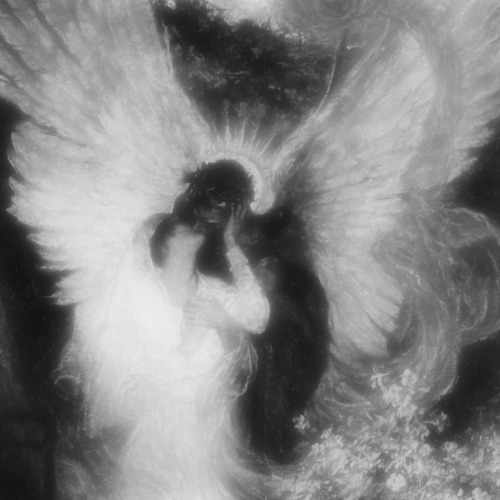Assorted Art Nouveau Charms Scanned By Me✧˖*°࿐






assorted art nouveau charms scanned by me✧˖*°࿐
More Posts from Bearieblues and Others






Instagram credit: __beanandbear__
In writing, epithets ("the taller man"/"the blonde"/etc) are inherently dehumanizing, in that they remove a character's name and identity, and instead focus on this other quality.
Which can be an extremely effective device within narration!
They can work very well for characters whose names the narrator doesn't know yet (especially to differentiate between two or more). How specific the epithet is can signal to the reader how important the character is going to be later on, and whether they should dedicate bandwidth to remembering them for later ("the bearded man" is much less likely to show up again than "the man with the angel tattoo")
They can indicate when characters stop being as an individual and instead embody their Role, like a detective choosing to think of their lover simply as The Thief when arresting them, or a royal character being referred to as The Queen when she's acting on behalf of the state
They can reveal the narrator's biases by repeatedly drawing attention to a particular quality that singles them out in the narrator's mind
But these only work if the epithet used is how the narrator primarily identifies that character. Which is why it's so jarring to see a lot of common epithets in intimate moments-- because it conveys that the main character is primarily thinking of their lover/best friend/etc in terms of their height or age or hair color.
“Give him to me.”
“I can’t. Not yet, at least.”
“What is there to possibly gain from him? He knows too much.”
“He knows more than me. That’s why I can’t get rid of him.”
Writing Rage: How To Make Your Characters Seem Angry

Anger is a powerful emotion that can add depth and intensity to your character's personality. If you're facing issues realistically expressing your characters' rage, here are some quick tips to help you get the ball rolling. Whether your character is seething with quiet rage or exploding in a fit of fury, these tips will help you convey their emotions vividly to your readers.
This is blog one in my writing different emotions series. Go check it out to explore more emotions!
Facial Expressions
Furrowed Brows: Describe the deep lines between their eyebrows, signaling frustration or intensity.
Tightened Jaw: Mention their clenched jaw, indicating suppressed anger or tension.
Narrowed Eyes: Highlight how their eyes narrow, showing suspicion, irritation, or anger.
Raised Upper Lip: Note the slight curl of the lip, suggesting disdain or contempt.
Flared Nostrils: Describe how their nostrils flare, indicating heightened emotions like anger or aggression.
Body Language and Gestures
Crossed Arms: Show their defensive stance, portraying resistance or defiance.
Pointing Finger: Describe them pointing accusatively, conveying aggression or assertion.
Fist Clenching: Mention their clenched fists, symbolizing anger or readiness for confrontation.
Hand Gestures: Detail specific hand movements like chopping motions, indicating frustration or emphasis.
Aggressive Posturing: Describe them leaning forward, invading personal space to intimidate or assert dominance.
Posture
Tense Shoulders: Highlight their raised or tense shoulders, indicating stress or readiness for conflict.
Upright Stance: Describe their rigid posture, showing control or a desire to appear strong.
Stiff Movements: Mention their jerky or abrupt movements, reflecting agitation or impatience.
Eye Contact
Intense Stares: Describe their intense or prolonged gaze, signaling confrontation or challenge.
Avoiding Eye Contact: Note how they avoid eye contact, suggesting discomfort or a desire to disengage.
Glaring: Mention how they glare at others, conveying hostility or disapproval.
Dialogue
Raised or strained tone with variations in pitch reflects heightened emotions.
Short, clipped sentences or abrupt pauses convey controlled anger.
Use of profanity or harsh language intensifies verbal expressions of anger.
Volume increase, from whispers to shouts, mirrors escalating anger levels.
Monotonous or sarcastic tone adds layers to angry dialogue.
Interruptions or talking over others signify impatience and frustration.
Aggressive verbal cues like "I can't believe..." or "How dare you..." express anger explicitly.
Reactions
Physical Reactions: Detail physical responses like increased heart rate, sweating, or trembling, showing emotional arousal.
Defensive Maneuvers: Describe how they react defensively if someone tries to touch or talk to them, such as stepping back or raising a hand to ward off contact.
Object Interaction
Aggressive Handling: Show them slamming objects, throwing things, or gripping items tightly, reflecting anger or aggression.
Use of Props: Mention how they use objects to emphasize their emotions, like slamming a door or clenching a pen.
Descriptive Words:
Verbs:
Roared with fury, expressing unbridled anger.
Snapped in frustration, indicating sudden irritation.
Shouted angrily, releasing pent-up emotions.
Glared fiercely, showing intense displeasure.
Slammed objects in rage, symbolizing anger's physical manifestation.
Grunted in annoyance, displaying impatience.
Raged vehemently, portraying uncontrolled anger.
Adjectives:
Furious and incensed, conveying intense anger.
Seething with rage, bubbling beneath the surface.
Livid and fuming, exhibiting visible anger.
Agitated and irritated, showing growing impatience.
Enraged and wrathful, expressing extreme anger.
Vexed and irate, indicating annoyance.
Infuriated and incandescent, highlighting explosive anger.
Looking For More Writing Tips And Tricks?
Are you an author looking for writing tips and tricks to better your manuscript? Or do you want to learn about how to get a literary agent, get published and properly market your book? Consider checking out the rest of Haya’s book blog where I post writing and publishing tips for authors every Monday and Thursday! And don’t forget to head over to my TikTok and Instagram profiles @hayatheauthor to learn more about my WIP and writing journey!
a little bunny looking at the stars in case you're having a bad day.
˚ . ✧
✧. ★ ˚
★ ☄︎
˚ ✧ ˚
*. ⋆
༘ * 🔭🐇
-
 kora-in-hell reblogged this · 1 month ago
kora-in-hell reblogged this · 1 month ago -
 wishfuldreamings liked this · 1 month ago
wishfuldreamings liked this · 1 month ago -
 always-mad-and-usually-drunk- reblogged this · 1 month ago
always-mad-and-usually-drunk- reblogged this · 1 month ago -
 underworldsghosts liked this · 1 month ago
underworldsghosts liked this · 1 month ago -
 boookthief reblogged this · 1 month ago
boookthief reblogged this · 1 month ago -
 isitevenyourblood liked this · 1 month ago
isitevenyourblood liked this · 1 month ago -
 unearthsea reblogged this · 1 month ago
unearthsea reblogged this · 1 month ago -
 unravelingsofanarrator reblogged this · 1 month ago
unravelingsofanarrator reblogged this · 1 month ago -
 thalycosa reblogged this · 1 month ago
thalycosa reblogged this · 1 month ago -
 evangalence liked this · 1 month ago
evangalence liked this · 1 month ago -
 cacaitos reblogged this · 1 month ago
cacaitos reblogged this · 1 month ago -
 mothofmay reblogged this · 1 month ago
mothofmay reblogged this · 1 month ago -
 bittersweetyrn reblogged this · 1 month ago
bittersweetyrn reblogged this · 1 month ago -
 nptvne reblogged this · 1 month ago
nptvne reblogged this · 1 month ago -
 sombernerd liked this · 2 months ago
sombernerd liked this · 2 months ago -
 dreamycreamygirl reblogged this · 2 months ago
dreamycreamygirl reblogged this · 2 months ago -
 thedollisdead reblogged this · 2 months ago
thedollisdead reblogged this · 2 months ago -
 thedollisdead liked this · 2 months ago
thedollisdead liked this · 2 months ago -
 marbobar liked this · 2 months ago
marbobar liked this · 2 months ago -
 grosutina reblogged this · 2 months ago
grosutina reblogged this · 2 months ago -
 theplasticman reblogged this · 2 months ago
theplasticman reblogged this · 2 months ago -
 theplasticman liked this · 2 months ago
theplasticman liked this · 2 months ago -
 stardustpools reblogged this · 2 months ago
stardustpools reblogged this · 2 months ago -
 kaifami liked this · 2 months ago
kaifami liked this · 2 months ago -
 plasticpony4 reblogged this · 2 months ago
plasticpony4 reblogged this · 2 months ago -
 p4w liked this · 2 months ago
p4w liked this · 2 months ago -
 plasticpony4 liked this · 2 months ago
plasticpony4 liked this · 2 months ago -
 archidendron liked this · 2 months ago
archidendron liked this · 2 months ago -
 roselinna liked this · 2 months ago
roselinna liked this · 2 months ago -
 nice--cunt reblogged this · 2 months ago
nice--cunt reblogged this · 2 months ago -
 rosescentedmoonmoth reblogged this · 2 months ago
rosescentedmoonmoth reblogged this · 2 months ago -
 aandjeo liked this · 2 months ago
aandjeo liked this · 2 months ago -
 spilldays liked this · 2 months ago
spilldays liked this · 2 months ago -
 firstloveinlatespring reblogged this · 2 months ago
firstloveinlatespring reblogged this · 2 months ago -
 catgirlsupremacist liked this · 2 months ago
catgirlsupremacist liked this · 2 months ago -
 urkuri liked this · 2 months ago
urkuri liked this · 2 months ago -
 missygoesmeow reblogged this · 2 months ago
missygoesmeow reblogged this · 2 months ago -
 jasper-dreams liked this · 2 months ago
jasper-dreams liked this · 2 months ago -
 angel-bruises reblogged this · 2 months ago
angel-bruises reblogged this · 2 months ago -
 fuckingcheerybeery reblogged this · 2 months ago
fuckingcheerybeery reblogged this · 2 months ago -
 platypusradio liked this · 2 months ago
platypusradio liked this · 2 months ago -
 help87 liked this · 2 months ago
help87 liked this · 2 months ago -
 osmanthusoolong reblogged this · 2 months ago
osmanthusoolong reblogged this · 2 months ago -
 gracklesong reblogged this · 2 months ago
gracklesong reblogged this · 2 months ago -
 irandompants liked this · 2 months ago
irandompants liked this · 2 months ago -
 evamasks liked this · 2 months ago
evamasks liked this · 2 months ago -
 spiritguide444 reblogged this · 2 months ago
spiritguide444 reblogged this · 2 months ago -
 birdsintheory liked this · 2 months ago
birdsintheory liked this · 2 months ago -
 daev3 liked this · 2 months ago
daev3 liked this · 2 months ago -
 arrowandaxe reblogged this · 2 months ago
arrowandaxe reblogged this · 2 months ago























